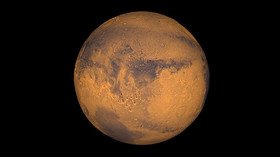Listen to the sky: NASA reveals the sound of wind on Mars (AUDIO)

For the first time, humans can hear the sound of wind on Mars thanks to a new NASA spacecraft that touched down on the Red Planet ten days ago.
NASA's new tool – the Interior Exploration using Seismic Investigations, Geodesy and Heat Transport – aka ‘InSight’ touched down on Mars on November 26.
On December 1, InSight sensors captured a haunting low rumble caused by vibrations from the wind, estimated to be blowing between 10 to 15 mph (16 to 24 kph). The winds were consistent with the direction of dust devil streaks in the landing area, which were observed from orbit, NASA reports.
BREAKING: Humans have never before heard the sound of wind on Mars until now! Listen to #SoundsOfMars as recorded by @NASAInSight as Martian winds swept over our lander. Best with headphones or a subwoofer. https://t.co/VreQxcAnAMpic.twitter.com/yd98NgZgR3
— Jim Bridenstine (@JimBridenstine) December 7, 2018
What’s even more exciting about InSight’s fascinating discovery is that the NASA team were not even planning on capturing the previously unheard wind.
“Capturing this audio was an unplanned treat,” said InSight principal investigator, Bruce Banerdt. “But one of the things our mission is dedicated to is measuring motion on Mars, and naturally that includes motion caused by sound waves.”
The wind vibrations were detected by two sensitive sensors on the InSight spacecraft: an air pressure sensor inside the lander and a seismometer sitting on the lander's deck.
Also on rt.com Mars InSight mission touches down on Red Planet – here’s what you need to knowInSight will act as a giant ear on Mars that will measure any sound or pressure fluctuations of the wind, earthquakes, tectonic movement or volcanism. However NASA promise an even clearer sound of the Red Planet is coming with the Mars 2020 rover that will have two microphones on board.
The rover will, for the first time, record the sound of its own landing. It will also record the sound of the instrument’s laser as it zaps different materials, helping to identify the material based on the sound it makes.














